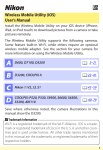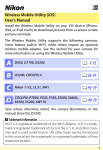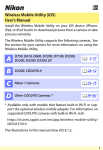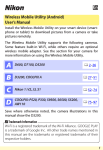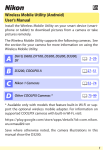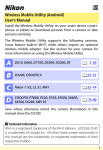Download Nikon D600 User's Manual
Transcript
En Wireless Mobile Utility (iOS) User’s Manual Install the Wireless Mobile Utility on your iOS device (iPhone, iPad, or iPod touch) to download pictures from a camera or take pictures remotely. The Wireless Mobile Utility supports the following cameras. Some feature built-in Wi-Fi, while others require an optional wireless mobile adapter. See the section for your camera for more information on using the Wireless Mobile Utility. A D600, D5200 0 2–19 B D3200 0 20–37 C Nikon 1: V2, J3, S1 0 38–53 D COOLPIX: P520, S9500, S6500, S5200, AW110 0 54–70 Save where otherwise noted, the camera illustrations in this manual show the D3200. A Trademark Information Wi-Fi is a registered trademark of the Wi-Fi Alliance. App Store is a trademark of Apple Inc. iOS is a trademark or registered trademark of Cisco in the U. S. A. and other countries and is used under license. All other trade names mentioned in this manual are the trademarks or registered trademarks of their respective holders. 1 A D600, D5200 This section describes the options available when the Wireless Mobile Utility and an optional wireless mobile adapter are used to connect to D600 and D5200 cameras. Features Use the Wireless Mobile Utility to: Take pictures remotely (0 5): Tap the shutter icon in the Wireless Mobile Utility to take pictures and download them to the iOS device. Download pictures as they are taken (0 8): Take pictures with the camera and save them to the iOS device. View pictures (0 10): View the pictures stored on the iOS device or the camera memory card. Download pictures (0 13): Download existing pictures from the camera memory card. Share pictures (0 15): Share pictures via e-mail or upload pictures to photo-sharing sites. For information on inserting the adapter, see page 4. A 2 Notices • No part of this manual may be reproduced, transmitted, transcribed, stored in a retrieval system, or translated into any language in any form without Nikon’s prior written permission. • Nikon reserves the right to change the specifications of the hardware and software described in this manual at any time and without prior notice. Nikon will not be held liable for damages that may result from any mistakes that this manual may contain. System Requirements Before installing the Wireless Mobile Utility, confirm that your iOS device meets the following system requirements: OS iOS 6.0 Wireless LAN 11b/g/n D Using This Application for the First Time Read the terms of use (0 19) before connecting. D The Wireless Mobile Adapter While the adapter is inserted, the camera exposure meters will not turn off; monitor the camera battery level to ensure that the camera does not power off unexpectedly. In addition, some camera menu items may be grayed out and unavailable and the camera can not be used for playback or live view. Movie recording can not be used. A 3 Installing the App 1 Locate the app on the App Store. Connect to the App Store on the iOS device and search for “Wireless Mobile Utility”. 2 Install the app. Install the Wireless Mobile Utility. Establishing a Wireless Connection 1 Connect the wireless mobile adapter. Attach the wireless mobile adapter to the camera and turn the camera on. See the manual supplied with the wireless mobile adapter for details. 2 Enable Wi-Fi on the iOS device. If Wi-Fi is off, turn it on. 3 Select the mobile adapter SSID. Select the mobile adapter SSID (the default SSID begins with “Nikon_WU_”). iOS-compliant devices can not be connected using WPS. 4 Launch the Wireless Mobile Utility. After selecting On for Privacy > Photos > WMU, launch the Wireless Mobile Utility. When a connection is established, the LED on the wireless mobile adapter will glow green and the main dialog for the Wireless Mobile Utility will be displayed on the iOS device. For information on taking pictures, see page 5. For information on viewing pictures, see page 10. A 4 Taking Photos Take pictures remotely from the iOS device, or take pictures with the camera and save them to the iOS device. Remote Photography Follow the steps below to take photos from the iOS device. 1 Tap Take photos. The camera viewfinder will go dark and the iOS device will display the view through the camera lens. 2 Focus. In normal- and wide-area AF AF-area modes, tap the subject in the display to focus (if subject-tracking AF is selected, the camera will focus using wide-area AF). A 5 3 Tap the shutter icon. The shutter will be released after you remove your finger from the icon; the resulting photo is first saved to the camera memory card and then downloaded to the iOS device. There is no need to point the iOS device at the wireless mobile adapter. D Remote Photography Remote photography ends automatically when the battery in the camera or iOS device runs low. Note that using remote photography for an extended period may cause the camera’s internal temperature to rise; if necessary, remote photography will end automatically to minimize damage to camera circuits. The iOS device can not be used to adjust camera settings; use camera controls to adjust settings before starting Step 1. Regardless of the release mode selected with the camera, only one picture will be taken each time you tap the shutter icon. Note that the display may not update smoothly depending on the device and network conditions. A shutter speed of “Time” is available in mode M. Choose a shutter speed of A on the camera and select Shoot > WMU on the iOS device (page 7), then tap the shutter icon to open the shutter. Shooting ends when the icon is tapped again. A 6 A The Remote Photography Display Top: Return to the top display. d: Display the following photographyrelated options. • Shoot: Choose whether to take pictures using the iOS device (WMU) or the camera (Camera). • Live view: Turn the live view display on or off. • Download after shooting: Choose whether pictures are automatically downloaded to the iOS device. Available only when WMU is selected for Shoot. • Self-timer: If On is selected, the camera shutter will be released 2 s after you tap the shutter icon. The timer turns off automatically after the shutter is released. Self-timer icon: Displayed when the selftimer is on. Camera settings: Shutter speed, aperture, etc. Not displayed when device is in landscape orientation. Thumbnail area: Downloaded pictures. A 7 Downloading Photos as They Are Taken Take photos with the camera and save them to the iOS device. 1 Tap Take photos. 2 Tap d. 3 Tap Camera. A 8 4 Take photos. Frame photos in the camera viewfinder and shoot. Photos are downloaded to the iOS device after being saved to the camera memory card. A The Photo Capture Display The photo capture display is shown below. d: Display Shoot options and choose whether to take pictures using the iOS device (WMU) or the camera (Camera). Top: Return to the top display. Thumbnail area: Downloaded pictures. A 9 Viewing Photos Tap View photos to view the pictures stored on the iOS device. You can also view the pictures on the camera memory card and download selected images to the iOS device. Viewing Pictures View the pictures in camera memory or on the iOS device. 1 A Tap View photos. 10 2 Choose a device. Tap Pictures on camera to view the pictures on the camera memory card, Camera roll to view the pictures stored in the camera roll on the iOS device. The pictures will be displayed as small “thumbnail” images (to return to the top display and take pictures or choose a different device, tap Top in the thumbnail list). 3 View pictures. Tap a thumbnail to display the picture full frame. You can then swipe left or right to view additional pictures, or tap a to view information about the current image. A 11 D Movies The Wireless Mobile Utility can not be used to view or download movies. D Deleting Pictures Pictures can not be deleted using the Wireless Mobile Utility, but pictures can be deleted from the camera roll on the iOS device. A Choosing a Folder The iOS device will either show a folder list or display the pictures on the camera memory card as small “thumbnail” images. When thumbnails are displayed, the folders can be viewed by tapping the f icon, while folders are displayed, you can tap a folder to view its contents in a thumbnail list. A 12 Downloading Existing Pictures Download pictures to the camera roll on the iOS device. 1 Tap View photos. 2 Tap Pictures on camera. Tap Pictures on camera to view the pictures on the camera. D Dropped Connections If the wireless connection is lost while a picture is being downloaded, the picture will not be saved to the iOS device (connection loss may occur if, for example, the camera turns off during download). Any pictures downloaded before the connection was interrupted are unaffected. A 13 3 Select pictures for download. Tap Select and then thumbnails to select or deselect. Selected pictures are indicated by a check mark. Alternatively, you can select pictures by tapping a picture in the thumbnail list to display it full frame and then tapping the check mark to select or deselect. Swipe left or right to view additional pictures or tap the folder name to return to the thumbnail list. 4 Tap Download. Tap Download to download the selected pictures to the camera roll on the iOS device. D Downloading Existing Pictures Existing pictures are automatically resized to the standard size for the iOS device. NEF (RAW) images are converted to JPEG format; if the images were recorded using an NEF (RAW) + JPEG option, only the JPEG copy will be downloaded. Exif data will be adapted to iOS specifications. A 14 Sharing Pictures Before sharing pictures, connect to a network with Internet access. 1 Tap View photos. 2 Choose Camera roll or Latest downloads. Tap Camera roll to view the pictures already downloaded to the iOS camera roll, Latest downloads to view the most recently downloaded photos (up to 12) at their original image quality and size. A 15 3 View pictures. Tap a thumbnail to view the picture full frame. 4 Tap b. After displaying a picture you want to share, tap b and choose from a list of picture-sharing apps and functions (the specific contents of the list vary from device to device). A 16 Wireless Mobile Utility Options The options listed below can be accessed by tapping the c icon in the Wireless Mobile Utility top display. Connection Status Option Description Camera The model name and battery level for the camera currently connected. Wireless Mobile Adapter View the wireless mobile adapter product name and firmware version. Settings Option Description Synchronize clock Synchronize the camera clock with the iOS device. Set camera clock Synchronize the camera clock with the iOS device. Set automatically Thumbnails A If On is selected, the camera clock will automatically be synchronized with the iOS device when a connection is established. Choose the size of the thumbnails in the playback display. 17 Option Description WMA settings (Wireless Mobile Adjust network settings for the wireless mobile adapter. Adapter settings) SSID Choose an SSID for the wireless mobile adapter. The iOS device displays the SSID when you connect to the network manually. Authentication Choose the authentication method used for connection to the network. Password Enter a password. The password type is selected using Advanced settings > Password entry: choose ASCII for an 8- to 63-character alphanumeric password, HEX for a 64-digit hexadecimal password. Channel Choose the wireless channel used by the network. Auto power-off Choose the delay before the wireless mobile adapter delay enters sleep when there is no wireless connection. Advanced settings • Password entry: Choose the password type. • Sub-net mask: Enter a subnet mask. • DHCP server IP address: Enter the wireless mobile adapter IP address. • DHCP client IP address: Enter the iOS device IP address. Restore factory Restore default settings. defaults Battery Warning Level Remote photography will end automatically when the camera or iOS device battery reaches the selected level. A 18 Help Option Description Instructions View instructions for using the Wireless Mobile Utility. Support websites Access the support site for the Wireless Mobile Utility. App View Wireless Mobile Utility version information. Terms of Use View the Wireless Mobile Utility terms of use. A 19 B D3200 This section describes the options available when the Wireless Mobile Utility and an optional wireless mobile adapter are used to connect to the D3200. Features Use the Wireless Mobile Utility to: Take pictures remotely (0 23): Tap the shutter icon in the Wireless Mobile Utility to take pictures and download them to the iOS device. Download pictures as they are taken (0 26): Take pictures with the camera and save them to the iOS device. View pictures (0 28): View the pictures stored on the iOS device or the camera memory card. Download pictures (0 31): Download existing pictures from the camera memory card. Share pictures (0 33): Share pictures via e-mail or upload pictures to photo-sharing sites. For information on inserting the adapter, see page 22. B 20 Notices • No part of this manual may be reproduced, transmitted, transcribed, stored in a retrieval system, or translated into any language in any form without Nikon’s prior written permission. • Nikon reserves the right to change the specifications of the hardware and software described in this manual at any time and without prior notice. Nikon will not be held liable for damages that may result from any mistakes that this manual may contain. System Requirements Before installing the Wireless Mobile Utility, confirm that your iOS device meets the following system requirements: OS iOS 6.0 Wireless LAN 11b/g/n D Using This Application for the First Time Read the terms of use (0 37) before connecting. D The Wireless Mobile Adapter While the adapter is inserted, the camera exposure meters will not turn off; monitor the camera battery level to ensure that the camera does not power off unexpectedly. In addition, some camera menu items may be grayed out and unavailable and the camera can not be used for playback or live view. Movie recording can not be used. B 21 Installing the App 1 Locate the app on the App Store. Connect to the App Store on the iOS device and search for “Wireless Mobile Utility”. 2 Install the app. Install the Wireless Mobile Utility. Establishing a Wireless Connection 1 Connect the wireless mobile adapter. Attach the wireless mobile adapter to the camera and turn the camera on. See the manual supplied with the wireless mobile adapter for details. 2 Enable Wi-Fi on the iOS device. If Wi-Fi is off, turn it on. 3 Select the mobile adapter SSID. Select the mobile adapter SSID (the default SSID begins with “Nikon_WU_”). iOS-compliant devices can not be connected using WPS. 4 Launch the Wireless Mobile Utility. After selecting On for Privacy > Photos > WMU, launch the Wireless Mobile Utility. When a connection is established, the LED on the wireless mobile adapter will glow green and the main dialog for the Wireless Mobile Utility will be displayed on the iOS device. For information on taking pictures, see page 23. For information on viewing pictures, see page 28. B 22 Taking Photos Take pictures remotely from the iOS device, or take pictures with the camera and save them to the iOS device. Remote Photography Follow the steps below to take photos from the iOS device. 1 Tap Take photos. The camera viewfinder will go dark and the iOS device will display the view through the camera lens. 2 Tap the shutter icon. Tap the shutter icon to focus (if subjecttracking AF is selected, the camera will focus using wide-area AF; note that no photo will be taken if the camera is unable to focus). The shutter will be released after you remove your finger from the icon; the resulting photo is first saved to the camera memory card and then downloaded to the iOS device. There is no need to point the iOS device at the wireless mobile adapter. B 23 D Remote Photography Remote photography ends automatically when the battery in the camera or iOS device runs low. Note that using remote photography for an extended period may cause the camera’s internal temperature to rise; if necessary, remote photography will end automatically to minimize damage to camera circuits. The iOS device can not be used to adjust camera settings; use camera controls to adjust settings before starting Step 1. Regardless of the release mode selected with the camera, only one picture will be taken each time you tap the shutter icon. Note that the display may not update smoothly depending on the device and network conditions. If the camera mode dial is rotated to i or j, pictures will be taken in mode P. Note that live view is not available when the camera is in GUIDE mode and Auto or No flash is selected for Easy operation. Select another option or rotate the mode dial to another setting. B 24 A The Remote Photography Display Top: Return to the top display. d: Display the following photographyrelated options. • Shoot: Choose whether to take pictures using the iOS device (WMU) or the camera (Camera). • Download after shooting: Choose whether pictures are automatically downloaded to the iOS device. Available only when WMU is selected for Shoot. • Self-timer: If On is selected, the camera shutter will be released 2 s after you tap the shutter icon. The timer turns off automatically after the shutter is released. Self-timer icon: Displayed when the selftimer is on. Camera settings: Shutter speed, aperture, etc. Not displayed when device is in landscape orientation. Thumbnail area: Downloaded pictures. B 25 Downloading Photos as They Are Taken Take photos with the camera and save them to the iOS device. 1 Tap Take photos. 2 Tap d. 3 Tap Camera. B 26 4 Take photos. Frame photos in the camera viewfinder and shoot. Photos are downloaded to the iOS device after being saved to the camera memory card. A The Photo Capture Display The photo capture display is shown below. d: Display Shoot options and choose whether to take pictures using the iOS device (WMU) or the camera (Camera). Top: Return to the top display. Thumbnail area: Downloaded pictures. B 27 Viewing Photos Tap View photos to view the pictures stored on the iOS device. You can also view the pictures on the camera memory card and download selected images to the iOS device. Viewing Pictures View the pictures in camera memory or on the iOS device. 1 B Tap View photos. 28 2 Choose a device. Tap Pictures on camera to view the pictures on the camera memory card, Camera roll to view the pictures stored in the camera roll on the iOS device. The pictures will be displayed as small “thumbnail” images (to return to the top display and take pictures or choose a different device, tap Top in the thumbnail list). 3 View pictures. Tap a thumbnail to display the picture full frame. You can then swipe left or right to view additional pictures, or tap a to view information about the current image. B 29 D Movies The Wireless Mobile Utility can not be used to view or download movies. D Deleting Pictures Pictures can not be deleted using the Wireless Mobile Utility, but pictures can be deleted from the camera roll on the iOS device. A Choosing a Folder The iOS device will either show a folder list or display the pictures on the camera memory card as small “thumbnail” images. When thumbnails are displayed, the folders can be viewed by tapping the f icon, while folders are displayed, you can tap a folder to view its contents in a thumbnail list. B 30 Downloading Existing Pictures Download pictures to the camera roll on the iOS device. 1 Tap View photos. 2 Tap Pictures on camera. Tap Pictures on camera to view the pictures on the camera. D Dropped Connections If the wireless connection is lost while a picture is being downloaded, the picture will not be saved to the iOS device (connection loss may occur if, for example, the camera turns off during download). Any pictures downloaded before the connection was interrupted are unaffected. B 31 3 Select pictures for download. Tap Select and then thumbnails to select or deselect. Selected pictures are indicated by a check mark. Alternatively, you can select pictures by tapping a picture in the thumbnail list to display it full frame and then tapping the check mark to select or deselect. Swipe left or right to view additional pictures or tap the folder name to return to the thumbnail list. 4 Tap Download. Tap Download to download the selected pictures to the camera roll on the iOS device D Downloading Existing Pictures Existing pictures are automatically resized to the standard size for the iOS device. NEF (RAW) images are converted to JPEG format; if the images were recorded using an NEF (RAW) + JPEG option, only the JPEG copy will be downloaded. Exif data will be adapted to iOS specifications. B 32 Sharing Pictures Before sharing pictures, connect to a network with Internet access. 1 Tap View photos. 2 Choose Camera roll or Latest downloads. Tap Camera roll to view the pictures already downloaded to the iOS camera roll, Latest downloads to view the most recently downloaded photos (up to 12) at their original image quality and size. B 33 3 View pictures. Tap a thumbnail to view the picture full frame. 4 Tap b. After displaying a picture you want to share, tap b and choose from a list of picture-sharing apps and functions (the specific contents of the list vary from device to device). B 34 Wireless Mobile Utility Options The options listed below can be accessed by tapping the c icon in the Wireless Mobile Utility top display. Connection Status Option Description Camera The model name and battery level for the camera currently connected. Wireless Mobile Adapter View the wireless mobile adapter product name and firmware version. Settings Option Description Synchronize clock Synchronize the camera clock with the iOS device. Set camera clock Synchronize the camera clock with the iOS device. Set automatically Thumbnails B If On is selected, the camera clock will automatically be synchronized with the iOS device when a connection is established. Choose the size of the thumbnails in the playback display. 35 Option Description WMA settings (Wireless Mobile Adjust network settings for the wireless mobile adapter. Adapter settings) SSID Choose an SSID for the wireless mobile adapter. The iOS device displays the SSID when you connect to the network manually. Authentication Choose the authentication method used for connection to the network. Password Enter a password. The password type is selected using Advanced settings > Password entry: choose ASCII for an 8- to 63-character alphanumeric password, HEX for a 64-digit hexadecimal password. Channel Choose the wireless channel used by the network. Auto power-off Choose the delay before the wireless mobile adapter delay enters sleep when there is no wireless connection. Advanced settings • Password entry: Choose the password type. • Sub-net mask: Enter a subnet mask. • DHCP server IP address: Enter the wireless mobile adapter IP address. • DHCP client IP address: Enter the iOS device IP address. Restore factory Restore default settings. defaults Battery Warning Level Remote photography will end automatically when the camera or iOS device battery reaches the selected level. B 36 Help Option Description Instructions View instructions for using the Wireless Mobile Utility. Support websites Access the support site for the Wireless Mobile Utility. App View Wireless Mobile Utility version information. Terms of Use View the Wireless Mobile Utility terms of use. B 37 C Nikon 1: V2, J3, S1 This section describes the options available when the Wireless Mobile Utility and an optional wireless mobile adapter are used to connect to Nikon 1 V2, J3, and S1 cameras. Features Use the Wireless Mobile Utility to: Take pictures remotely (0 41): Tap the shutter icon in the Wireless Mobile Utility to take pictures and download them to the iOS device. View pictures (0 44): View the pictures stored on the iOS device or the camera memory card. Download pictures (0 47): Download existing pictures from the camera memory card. Share pictures (0 49): Share pictures via e-mail or upload pictures to photo-sharing sites. For information on inserting the adapter, see page 40. C 38 Notices • No part of this manual may be reproduced, transmitted, transcribed, stored in a retrieval system, or translated into any language in any form without Nikon’s prior written permission. • Nikon reserves the right to change the specifications of the hardware and software described in this manual at any time and without prior notice. Nikon will not be held liable for damages that may result from any mistakes that this manual may contain. System Requirements Before installing the Wireless Mobile Utility, confirm that your iOS device meets the following system requirements: OS iOS 6.0 Wireless LAN 11b/g/n D Using This Application for the First Time Read the terms of use (0 53) before connecting. D The Wireless Mobile Adapter While the adapter is inserted, the camera exposure meters will not turn off; monitor the camera battery level to ensure that the camera does not power off unexpectedly. In addition, some camera menu items may be grayed out and unavailable and the camera can not be used for playback or live view. Movie recording can not be used. C 39 Installing the App 1 Locate the app on the App Store. Connect to the App Store on the iOS device and search for “Wireless Mobile Utility”. 2 Install the app. Install the Wireless Mobile Utility. Establishing a Wireless Connection 1 Connect the wireless mobile adapter. Attach the wireless mobile adapter to the camera and turn the camera on. See the manual supplied with the wireless mobile adapter for details. 2 Enable Wi-Fi on the iOS device. If Wi-Fi is off, turn it on. 3 Select the mobile adapter SSID. Select the mobile adapter SSID (the default SSID begins with “Nikon_WU_”). iOS-compliant devices can not be connected using WPS. 4 Launch the Wireless Mobile Utility. After selecting On for Privacy > Photos > WMU, launch the Wireless Mobile Utility. When a connection is established, the LED on the wireless mobile adapter will glow green and the main dialog for the Wireless Mobile Utility will be displayed on the iOS device. For information on taking pictures, see page 41. For information on viewing pictures, see page 44. C 40 Taking Photos Follow the steps below to take photos from the iOS device. 1 Tap Take photos. The camera viewfinder will go dark and the iOS device will display the view through the camera lens. 2 Tap the shutter icon. The shutter will be released after you remove your finger from the icon and the camera focuses (note that no photo will be taken if the camera is unable to focus); the resulting photo is first saved to the camera memory card and then downloaded to the iOS device. There is no need to point the iOS device at the wireless mobile adapter. C 41 D Remote Photography Remote photography ends automatically when the battery in the camera or iOS device runs low. Note that using remote photography for an extended period may cause the camera’s internal temperature to rise; if necessary, remote photography will end automatically to minimize damage to camera circuits. The iOS device can not be used to adjust camera settings; use camera controls to adjust settings before starting Step 1. Regardless of the release mode selected with the camera, only one picture will be taken each time you tap the shutter icon. Note that the display may not update smoothly depending on the device and network conditions. Regardless of the settings selected with the camera, pictures will be taken in mode P (programmed auto) using single-servo autofocus (AF-S) and auto-area AF. Face-priority AF is disabled and the focus point is not displayed. C 42 A The Remote Photography Display Top: Return to the top display. d: Display the following photographyrelated options. • Download after shooting: Choose whether pictures are automatically downloaded to the iOS device. • Self-timer: If On is selected, the camera shutter will be released 2 s after you tap the shutter icon. The timer turns off automatically after the shutter is released. Self-timer icon: Displayed when the selftimer is on. Camera settings: Shutter speed, aperture, etc. Not displayed when device is in landscape orientation. Thumbnail area: Downloaded pictures. C 43 Viewing Photos Tap View photos to view the pictures stored on the iOS device. You can also view the pictures on the camera memory card and download selected images to the iOS device. Viewing Pictures View the pictures in camera memory or on the iOS device. 1 C Tap View photos. 44 2 Choose a device. Tap Pictures on camera to view the pictures on the camera memory card, Camera roll to view the pictures stored in the camera roll on the iOS device. The pictures will be displayed as small “thumbnail” images (to return to the top display and take pictures or choose a different device, tap Top in the thumbnail list). 3 View pictures. Tap a thumbnail to display the picture full frame. You can then swipe left or right to view additional pictures, or tap a to view information about the current image. C 45 D Movies The Wireless Mobile Utility can not be used to view or download movies. D Deleting Pictures Pictures can not be deleted using the Wireless Mobile Utility, but pictures can be deleted from the camera roll on the iOS device. A Choosing a Folder The iOS device will either show a folder list or display the pictures on the camera memory card as small “thumbnail” images. When thumbnails are displayed, the folders can be viewed by tapping the f icon, while folders are displayed, you can tap a folder to view its contents in a thumbnail list. C 46 Downloading Existing Pictures Download pictures to the camera roll on the iOS device. 1 Tap View photos. 2 Tap Pictures on camera. Tap Pictures on camera to view the pictures on the camera. D Dropped Connections If the wireless connection is lost while a picture is being downloaded, the picture will not be saved to the iOS device (connection loss may occur if, for example, the camera turns off during download). Any pictures downloaded before the connection was interrupted are unaffected. C 47 3 Select pictures for download. Tap Select and then thumbnails to select or deselect. Selected pictures are indicated by a check mark. Alternatively, you can select pictures by tapping a picture in the thumbnail list to display it full frame and then tapping the check mark to select or deselect. Swipe left or right to view additional pictures or tap the folder name to return to the thumbnail list. 4 Tap Download. Tap Download to download the selected pictures to the camera roll on the iOS device. D Downloading Existing Pictures Existing pictures are automatically resized to the standard size for the iOS device. NEF (RAW) images are converted to JPEG format; if the images were recorded using an NEF (RAW) + JPEG option, only the JPEG copy will be downloaded. Exif data will be adapted to iOS specifications. C 48 Sharing Pictures Before sharing pictures, connect to a network with Internet access. 1 Tap View photos. 2 Choose Camera roll or Latest downloads. Tap Camera roll to view the pictures already downloaded to the iOS camera roll, Latest downloads to view the most recently downloaded photos (up to 12) at their original image quality and size. C 49 3 View pictures. Tap a thumbnail to view the picture full frame. 4 Tap b. After displaying a picture you want to share, tap b and choose from a list of picture-sharing apps and functions (the specific contents of the list vary from device to device). C 50 Wireless Mobile Utility Options The options listed below can be accessed by tapping the c icon in the Wireless Mobile Utility top display. Connection Status Option Description Camera The model name and battery level for the camera currently connected. Wireless Mobile Adapter View the wireless mobile adapter product name and firmware version. Settings Option Description Synchronize clock Synchronize the camera clock with the iOS device. Set camera clock Synchronize the camera clock with the iOS device. Set automatically Thumbnails C If On is selected, the camera clock will automatically be synchronized with the iOS device when a connection is established. Choose the size of the thumbnails in the playback display. 51 Option Description WMA settings (Wireless Mobile Adjust network settings for the wireless mobile adapter. Adapter settings) SSID Choose an SSID for the wireless mobile adapter. The iOS device displays the SSID when you connect to the network manually. Authentication Choose the authentication method used for connection to the network. Password Enter a password. The password type is selected using Advanced settings > Password entry: choose ASCII for an 8- to 63-character alphanumeric password, HEX for a 64-digit hexadecimal password. Channel Choose the wireless channel used by the network. Auto power-off Choose the delay before the wireless mobile adapter delay enters sleep when there is no wireless connection. Advanced settings • Password entry: Choose the password type. • Sub-net mask: Enter a subnet mask. • DHCP server IP address: Enter the wireless mobile adapter IP address. • DHCP client IP address: Enter the iOS device IP address. Restore factory Restore default settings. defaults Battery Warning Level Remote photography will end automatically when the camera or iOS device battery reaches the selected level. C 52 Help Option Description Instructions View instructions for using the Wireless Mobile Utility. Support websites Access the support site for the Wireless Mobile Utility. App View Wireless Mobile Utility version information. Terms of Use View the Wireless Mobile Utility terms of use. C 53 D COOLPIX: P520, S9500, S6500, S5200, AW110 This section describes the options available when the Wireless Mobile Utility is used to connect to COOLPIX P520, S9500, S6500, S5200, and AW110 cameras. Features Use the Wireless Mobile Utility to: Take pictures remotely (0 58): Tap the shutter icon in the Wireless Mobile Utility to take pictures and download them to the iOS device. View pictures (0 61): View the pictures stored on the iOS device or the camera memory card. Download pictures (0 64): Download existing pictures from the camera memory card. Share pictures (0 66): Share pictures via e-mail or upload pictures to photo-sharing sites. Note that an optional wireless mobile adapter is required when the app is used with cameras not equipped with built-in wireless; for information on inserting the adapter, see page 56. D 54 Notices • No part of this manual may be reproduced, transmitted, transcribed, stored in a retrieval system, or translated into any language in any form without Nikon’s prior written permission. • Nikon reserves the right to change the specifications of the hardware and software described in this manual at any time and without prior notice. Nikon will not be held liable for damages that may result from any mistakes that this manual may contain. System Requirements Before installing the Wireless Mobile Utility, confirm that your iOS device meets the following system requirements: OS iOS 6.0 Wireless LAN 11b/g/n D Using This Application for the First Time Read the terms of use (0 70) before connecting. D 55 Installing the App 1 Locate the app on the App Store. Connect to the App Store on the iOS device and search for “Wireless Mobile Utility”. 2 Install the app. Install the Wireless Mobile Utility. Establishing a Wireless Connection The following applies only to cameras without built-in Wi-Fi. For information on cameras with built-in Wi-Fi, see the manual provided with the camera. 1 Connect the wireless mobile adapter. Attach the wireless mobile adapter to the camera and turn the camera on. See the manual supplied with the wireless mobile adapter for details. 2 Enable Wi-Fi on the iOS device. If Wi-Fi is off, turn it on. 3 Select the mobile adapter SSID. Select the mobile adapter SSID (the default SSID begins with “Nikon”). iOS-compliant devices can not be connected using WPS. 4 Launch the Wireless Mobile Utility. After selecting On for Privacy > Photos > WMU, launch the Wireless Mobile Utility. When a connection is established, the LED on the wireless mobile adapter will glow green and the main dialog for the Wireless Mobile Utility will be displayed on the iOS device. Take and view pictures as described on pages 58 and 61, respectively. D 56 D The Wireless Mobile Adapter (for Cameras Without Built-in Wi-Fi) While the adapter is inserted, the camera exposure meters will not turn off; monitor the camera battery level to ensure that the camera does not power off unexpectedly. In addition, some camera menu items may be grayed out and unavailable and the camera can not be used for playback or live view. Movie recording can not be used. D 57 Taking Photos Follow the steps below to take photos from the iOS device. 1 Tap Take photos. The camera viewfinder will go dark and the iOS device will display the view through the camera lens. 2 Tap the shutter icon. The shutter will be released after you remove your finger from the icon and the camera focuses; the resulting photo is first saved to the camera memory card and then downloaded to the iOS device. There is no need to point the iOS device at the wireless mobile adapter. D 58 D Remote Photography Remote photography ends automatically when the battery in the camera or iOS device runs low. Note that using remote photography for an extended period may cause the camera’s internal temperature to rise; if necessary, remote photography will end automatically to minimize damage to camera circuits. The iOS device can not be used to adjust camera settings; use camera controls to adjust settings before starting Step 1. Regardless of the release mode selected with the camera, only one picture will be taken each time you tap the shutter icon. Note that the display may not update smoothly depending on the device and network conditions. Regardless of the settings selected with the camera, pictures will be taken in C (auto) mode using target finding autofocus. The focus point is not displayed. D 59 A The Remote Photography Display Top: Return to the top display. d: Display the following photographyrelated options. • Download after shooting: Choose whether pictures are automatically downloaded to the iOS device. • Self-timer: If On is selected, the camera shutter will be released 2 s after you tap the shutter icon. The timer turns off automatically after the shutter is released. Self-timer icon: Displayed when the selftimer is on. Camera settings: Shutter speed, aperture, etc. Not displayed when device is in landscape orientation. Optical zoom: Tap T to zoom in, W to zoom out. Thumbnail area: Downloaded pictures. D 60 Viewing Photos Tap View photos to view the pictures stored on the iOS device. You can also view the pictures on the camera memory card and download selected images to the iOS device. Viewing Pictures View the pictures in camera memory or on the iOS device. 1 D Tap View photos. 61 2 Choose a device. Tap Pictures on camera to view the pictures on the camera memory card, Camera roll to view the pictures stored in the camera roll on the iOS device. The pictures will be displayed as small “thumbnail” images (to return to the top display and take pictures or choose a different device, tap Top in the thumbnail list). 3 View pictures. Tap a thumbnail to display the picture full frame. You can then swipe left or right to view additional pictures, or tap a to view information about the current image. D 62 D Movies The Wireless Mobile Utility can not be used to view or download movies. D Deleting Pictures Pictures can not be deleted using the Wireless Mobile Utility, but pictures can be deleted from the camera roll on the iOS device. A Choosing a Folder The iOS device will either show a folder list or display the pictures on the camera memory card as small “thumbnail” images. When thumbnails are displayed, the folders can be viewed by tapping the f icon, while folders are displayed, you can tap a folder to view its contents in a thumbnail list. D 63 Downloading Existing Pictures Download pictures to the camera roll on the iOS device. 1 Tap View photos. 2 Tap Pictures on camera. Tap Pictures on camera to view the pictures on the camera. D Dropped Connections If the wireless connection is lost while a picture is being downloaded, the picture will not be saved to the iOS device (connection loss may occur if, for example, the camera turns off during download). Any pictures downloaded before the connection was interrupted are unaffected. D 64 3 Select pictures for download. Tap Select and then thumbnails to select or deselect. Selected pictures are indicated by a check mark. Alternatively, you can select pictures by tapping a picture in the thumbnail list to display it full frame and then tapping the check mark to select or deselect. Swipe left or right to view additional pictures or tap the folder name to return to the thumbnail list. 4 Tap Download. Tap Download to download the selected pictures to the camera roll on the iOS device. D Downloading Existing Pictures Existing pictures are automatically resized to the standard size for the iOS device. NEF (RAW) images are converted to JPEG format; if the images were recorded using an NEF (RAW) + JPEG option, only the JPEG copy will be downloaded. 3D images are converted to 2D JPEG images. Exif data will be adapted to iOS specifications. D 65 Sharing Pictures Before sharing pictures, connect to a network with Internet access. 1 Tap View photos. 2 Choose Camera roll or Latest downloads. Tap Camera roll to view the pictures already downloaded to the iOS camera roll, Latest downloads to view the most recently downloaded photos (up to 12) at their original image quality and size (3D images are however converted to 2D JPEG images). D 66 3 View pictures. Tap a thumbnail to view the picture full frame. 4 Tap b. After displaying a picture you want to share, tap b and choose from a list of picture-sharing apps and functions (the specific contents of the list vary from device to device). D 67 Wireless Mobile Utility Options The options listed below can be accessed by tapping the c icon in the Wireless Mobile Utility top display. Connection Status Option Description Camera The model name and battery level for the camera currently connected. Wireless Mobile Adapter View the wireless mobile adapter product name and firmware version. Not available with cameras that feature built-in Wi-Fi. Settings Option Description Synchronize clock Synchronize the camera clock with the iOS device. Set camera clock Synchronize the camera clock with the iOS device. Set automatically Thumbnails D If On is selected, the camera clock will automatically be synchronized with the iOS device when a connection is established. Choose the size of the thumbnails in the playback display. 68 Option Description WMA settings Adjust network settings for the wireless mobile adapter. (Wireless Mobile Not available with cameras that feature built-in Wi-Fi. Adapter settings) SSID Choose an SSID for the wireless mobile adapter. The iOS device displays the SSID when you connect to the network manually. Authentication Choose the authentication method used for connection to the network. Password Enter a password. The password type is selected using Advanced settings > Password entry: choose ASCII for an 8- to 63-character alphanumeric password, HEX for a 64-digit hexadecimal password. Channel Choose the wireless channel used by the network. Auto power-off Choose the delay before the wireless mobile adapter delay enters sleep when there is no wireless connection. Advanced settings • Password entry: Choose the password type. • Sub-net mask: Enter a subnet mask. • DHCP server IP address: Enter the wireless mobile adapter IP address. • DHCP client IP address: Enter the iOS device IP address. Restore factory Restore default settings. defaults Battery Warning Level Remote photography will end automatically when the camera or iOS device battery reaches the selected level. D 69 Help Option Description Instructions View instructions for using the Wireless Mobile Utility. Support websites Access the support site for the Wireless Mobile Utility. App View Wireless Mobile Utility version information. Terms of Use View the Wireless Mobile Utility terms of use. SB3A04(11) 6MWA3311-04 D 70






































































